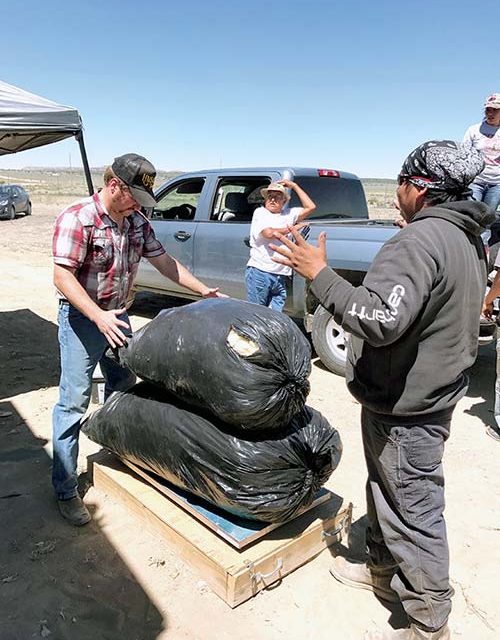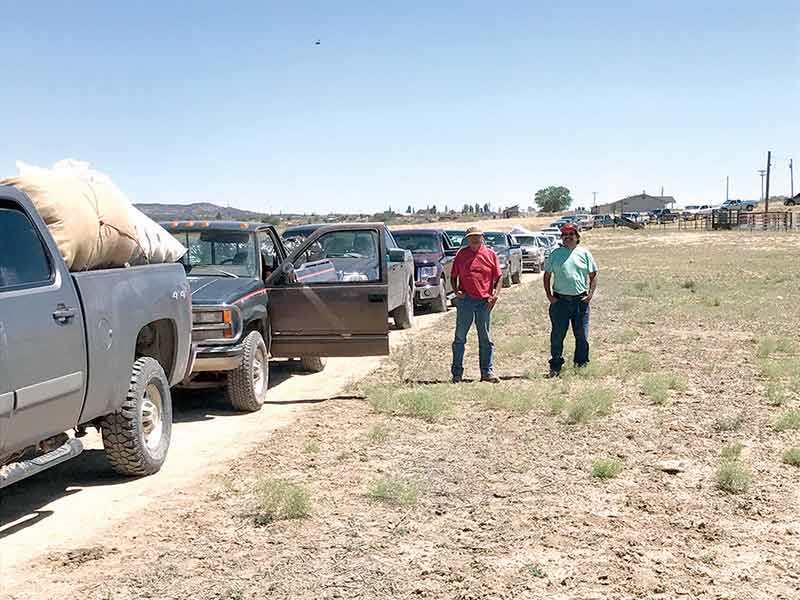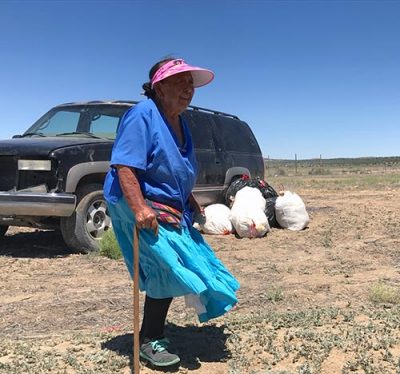
Not getting fleeced

Navajo Times / Cindy Yurth Bags of wool are weighed as the seller looks on June 15 in Pinon, Arizona.
Wool buyers say they have motives beyond profit

Navajo Times / Cindy Yurth
Wool producers stretch their legs as they wait to have their wool graded and weighed.
PIÑON, Ariz.
For decades, the only place for Navajo ranchers to sell their wool was at the trading post. As trading posts became fewer, and fewer of them stayed in the wool business, the prices fell, but most ranchers gritted their teeth and accepted it, not having the money to drive out of the area to look for a better price.

Navajo Times / Cindy Yurth
Daisy Begay of Burnt Corn, Arizona, waits for her wool to be weighed Thursday in Pinon, Arizona.
For the last six years, they’ve had another alternative, and many of them are taking advantage of it: A coalition of wool and mohair buyers has been coming to the rez.
Not only do the growers not have to drive as far — the buyers figure any one of their stops is within 40 miles of most of the ranchers in the area — but the prices are better. These guys are sort of reverse capitalists. They’re deliberately trying to drive up the price, as long as they can still make a modest profit.
“I call it economic jujitsu,” said Edward R. “Teddy” Varndell, the mohair buyer. “The first year we came out, the border towns were offering 40 cents a pound for mohair. I started offering 75 cents. The border towns went to $1.50. So we went to $1.60.”
This is not something you’re likely to learn in business school. But Varndell and the other buyers, Stanley Strode of Mid-States Wool Growers and Peter Hagerty of Peace Fleece, are not your average businessmen.
“It’s not philanthropy by any means,” said Varndell. “We are trying to make a living. But we want to do it in a way that we can help support the economy and the culture on the reservation.”
The group comes a couple of times a year and makes a circuit of the major wool-growing chapters, setting up at chapter houses or fairgrounds with a tractor-trailer, scales and a checkbook.
Sellers line up in their trucks laden with plastic sacks full of wool or mohair — at Piñon last Thursday, at least 25 trucks were lined up, making a circle around the rodeo grounds. They pull up to a canopy set up by the tractor-trailer, and Strode or Varndell (depending on whether the producers are selling wool or mohair), strides out, slashes a slit in one of the bags, and pulls out a tuft of fluff in order to grade it and offer a price.
The highest-grade wool or mohair is clean and white, not because the buyers are prejudiced against black sheep but because, as Strode explained, “The only color you can dye black wool is black,” so there’s little demand for it.
A sheep or goat’s first shearing will generally fetch the highest price.
“It’s finer and softer,” explained Varndell. “It never grows back like that again.”
Strode looks for wool that is not mixed with hair. Some sheep, particularly churros and churro crosses, have both wool and hair.
“Hair is a hollow fiber. It dyes from the inside out,” he explained. “Wool has a solid core, and dyes from the outside in.”
Unfortunately, said Strode, there’s not much market for churro wool right now because of its high hair content. Diné producers can improve their product by keeping their churro rams away from their Rambouillet ewes.
The market for wool and mohair is down a bit this year because the dollar is strong against the euro, meaning sellers take a loss when their product is exported, and China, the world’s biggest wool importer, has undertaken a concerted effort to raise more sheep for its own market.
At Thursday’s buying event in Piñon, wool was fetching 20 cents to $1.20 a pound, depending on quality, and mohair was a little higher. One seller said the price was twice as much as she was recently offered in Gallup.
Producers are often surprised to learn their wool ends up all over the world. In the case of mohair, it can’t even be processed in the U.S.

Navajo Times / Cindy Yurth
Bags of wool are weighed as the seller looks on June 15 in Pinon, Arizona.
“There’s no more primary processing plants for mohair in the U.S.,” explained Varndell, who comes out to the rez from Chicago. “It goes from here to England, with a stop in Ohio, where it’s inspected for export.”
At a plant in the U.K., it’s sorted, graded and scoured, then shipped to other plants where it’s carded and culled.
“From there, it goes all over the place,” Varndell said. “Mostly Italy, where it ends up in everything from clothing to fine carpets.”
So if you’re strolling the Via Veneto some day, don’t be surprised if you hear a familiar “baa” from someone’s sweater.
Wool is a little easier, said Strode, who comes out from Ohio.
The Navajo wool Mid-States buys is shipped to South Carolina for processing, then on to Europe for spinning and garment production, following a similar path to Varndell’s mohair.
The three buyers got into the wool business for different reasons.
Mid-States is a cooperative that will celebrate its centennial next year. Its aim is to find markets and get producers in 23 states the best price for their wool.
Varndell is an independent businessman whose braided beard and tie-dyed T-shirt would get him kicked out of most boardrooms.
His card reads simply “Objects of Interest.” He got interested in wool and mohair after being drawn in to efforts to preserve the churro sheep.
The ambitions of Hagerty’s high-end yarn company, Peace Fleece, go way beyond fair commerce.
“Our goal,” declared the Maine resident as he squinted into Thursday’s merciless desert sun, “is to link historic enemies through the wool trade.” Let’s just say it: world peace.
Hagerty and his wife, Marty Tracy, started buying wool from the Soviet Union in 1985, hoping to defuse the threat of nuclear war.
They then moved on to the Middle East, finding Israeli markets for Palestinian shepherds.
In 2009, realizing there was plenty of peace work to be done (and wool to be sold) in this country, they moved on to the Sioux reservations, forging cooperative efforts between white and Native ranchers.
The Black Mesa Water Coalition invited Peace Fleece and its compadres to Diné Bikéyah in 2011 in the hopes of giving remote ranchers in the Black Mesa region better access to markets. It’s one of Hagerty’s favorite locations.
“Not only do we have a wonderful time in this culture,” he said, “we re-learn some traditional American values, such as respect for elders and a connection with the land. It’s wonderful to see people in their teens and twenties coming out with their grandparents to sell their wool.
“Recently,” he said, “I met a married couple — she was 100, he was 101 — who just finished shearing their 40 sheep by themselves!”
Hagerty says the buying program has grown every year — according to Varndell, they purchase a total of 4,000 to 6,000 pounds of wool and mohair every trip — and he loves seeing families returning year after year.
For ranchers like Marie Duffy of Burnt Corn, Arizona, and her 78-year-old mother, Daisy Begay, the buying event not only fetches them a better price but saves them a grueling three-hour round trip to Gallup, smelling lanolin from the wool in the back end of their SUV.
Duffy pointed out that her mother had to see her doctor in Flagstaff that afternoon (as if to prove this, Begay lifted her traditional skirt to reveal an ace bandage tightly wrapped around one knee), and they never would have been able to keep that appointment if they had had to drive to Gallup first.
“And the man in Gallup, he don’t even give us a price for the black one (wool),” Duffy added.
Begay smiled as she pocketed her check, grabbing a brochure with a picture of sheep on the cover.
“Look how pretty these sheep are, with their black faces!” she exclaimed to Duffy in Navajo as the women walked back to their SUV, three bags of wool lighter and cash in hand for their journey to the city.
To read the full article, pick up your copy of the Navajo Times at your nearest newsstand Thursday mornings!
Are you a digital subscriber? Read the most recent three weeks of stories by logging in to your online account.








 Highway 264,
Highway 264, I-40, WB @ Winslow
I-40, WB @ Winslow